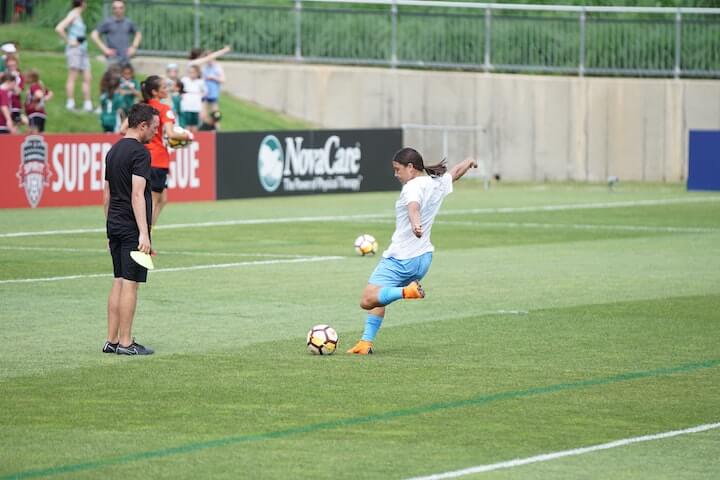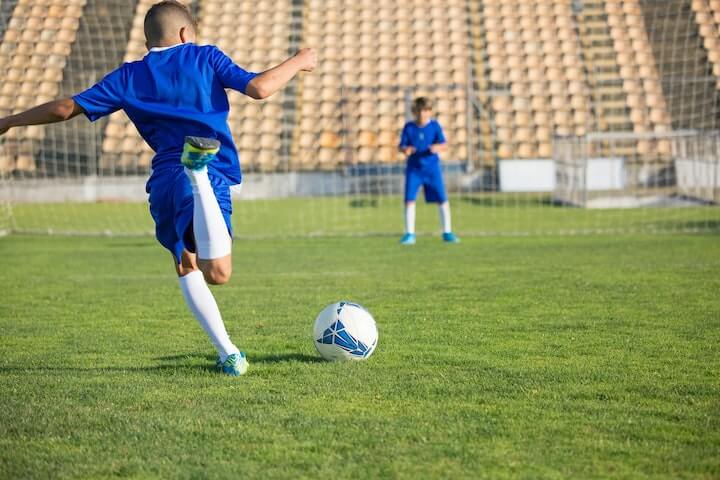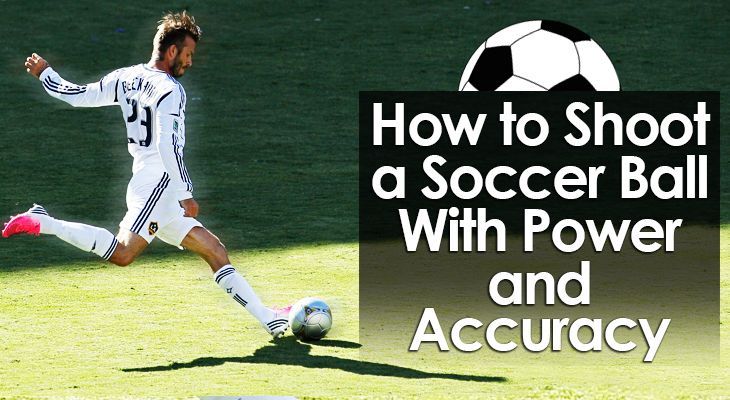How to Shoot a Soccer Ball (With Power and Accuracy)
Shooting is a fundamental skill that players must first learn and then practice on regularly.
We often hear soccer commentators speak about a player’s natural ability to strike a ball with precision accuracy or unworldly power.
While it’s true that some stars are naturally talented, shooting with power and accuracy typically comes from good technique.
Learning how to shoot a soccer ball correctly provides the perfect building blocks for mastering the art of striking.
Shooting with power and accuracy comes down to balance, technique, correct body positioning, and follow-through.
In this article, I break down 9 key tips to help you learn how to shoot a soccer ball with power and accuracy.
How to Shoot a Soccer Ball (9 Steps)
Step #1: Maintain Your Balance
When discussing striking technique, many coaches only examine the point of contact between the cleat and the ball.
A lot of them forget to address other important factors around it -- like balance or body shape.
To focus solely on the connection between the foot and the ball would be silly.
Aside from free kicks and penalties, players rarely get the chance to meet the ball in the perfect position and from an ideal angle.
Therefore...
The first step in taking a clean shot with power and accuracy is to find your balance.
Focus on the ball, steady yourself, and slow down if necessary.
This puts you in the best position to strike the ball hard and true, sending it hurtling toward goal.
Step #2: Line Up The Shot
Another overlooked step in shooting a soccer ball is lining up the shot.
Essentially, this means creating the right angle to line up your shot.
Most players’ ideal shooting angle is approximately 45 degrees (give or take).
This gives you an ideal position to maintain balance, generate power, and shoot in either direction.
When eyeing up a shot, anticipate where the ball will be when you strike it, and take a couple of short steps (if necessary) to create an optimal shooting angle.
In-game, you never know how much time or distance you’ll have for your run-up.
So making a habit of taking a few quick short steps before shooting helps ensure you’re poised to shoot at any given moment.
This keeps you on your toes and your muscles engaged to get a crisp shot away.
Step #3: Plant Your Standing Leg Next to the Ball
Now comes the most critical part: striking the ball.
When learning how to shoot a soccer ball, it’s important to note that the standing foot is almost as vital as the striking one.
Placing your standing foot right next to the ball gives you stability and helps guide your shooting foot through the ball.
Point your standing foot in the direction you’re shooting. Doing so turns your body toward goal, helping with accuracy.
Using this technique also helps when crossing the ball from wide areas.
Although it seems basic, many players skew their shots because their standing foot is pointing away from the target.
If improving accuracy is your main focus, concentrating on the position of your standing foot should be priority number one.

Step #4: Get a Sufficient Backlift
When the ball is moving, getting backlift on your shooting leg isn’t essential.
In such cases, you can “let the ball do the work” and put most of your effort into connection.
With a stationary ball, however, backlift provides the force and power needed for a hard and accurate strike.
"How much backlift do you need?"
This can vary, but as a rule of thumb, lift your shooting leg until it almost hits your backside.
As you swing your leg backward, you might find that your opposite arm naturally comes outward to help you maintain balance. This provides perfect counterbalance when standing on one leg, so that’s a good sign.
If you’re struggling to stay balanced when shooting, analyze your standing foot position, backlift, and opposite arm. It’s likely that one of these is affecting your technique.
Step #5: Don’t Lean Back
One of the golden rules when learning how to shoot a soccer ball is to:
Avoid leaning backward.
Doing so angles your body toward the sky, causing shots to soar high over the crossbar.
Unfortunately, leaning back feels natural when shooting, so many players develop this bad habit.
Getting out of this habit requires practice and focus. Be conscious of your upper body, engage your core, and keep your eye on the ball when taking a strike.
Another good tip is to keep your head down while you shoot.
Focus on the ball and it will go where you want it to.
Target fixation can cause you to lose focus on your technique and is often the main reason for leaning back.
Although David Beckham, perhaps the finest striker of the ball we’ve ever seen, defies this golden rule, he’s very much an exception.
Step #6: Strike the Ball With Your Instep
You can kick a ball with virtually any part of your foot, from your toes to your heel.
When going for pure power, many people advise to “kick with your laces”.
If accuracy is the priority, people prefer the inside of the foot.
However, to combine power and accuracy, striking with the instep is the sweet spot.
Your instep is on the top of your foot, just above the arch.
By striking the ball with your instep, you get a maximum connection between the foot and the ball, helping you generate both force and accuracy.
Depending on the angle of your shooting foot, you can power low drives or curling shots on goal.
To keep your shot low, point your toes toward the turf.
If you want to elevate the ball, curl the toes slightly and get under the ball a little more than usual.
At the point of contact, be sure to lock your ankle so your foot is rigid.
This helps carry the power generated through your legs.

Step #7: Follow-Through
A good follow-through ensures maximum power goes through the ball and also helps guide it in the right direction.
"Pulling your shot" (failing to follow through) essentially causes your foot to slap off the ball, limiting the power and reducing your control over accuracy.
By following through on your strike, you make sure the ball carries the full force of your body, unleashing a powerful shot.
Shooting with power and accuracy is less about trying to burst the ball with your foot, and more about using your entire body to generate the force your need.
The follow-through is the final step in delivering unstoppable shots on goal.
Step #8: Practice, Practice, Practice
Even at the highest level, there’s no substitute for practice.
There’s a reason professional strikers do extra shooting drills and finishing drills after training.
Developing instinctual shooting comes from constant repetition.
The most natural and fluid-looking strikers of a ball have all put in their 10,000 hours of technique training. Then, they follow it up with situational drills and shooting practice.
If you have access to a goal, spend time shooting at different parts: left bottom, right top, left mid, right bottom, etc.
Start out inside the penalty box and gradually increase the distance as you improve.
With each shot, remember the most important aspects of your technique:
- Balance
- Lining up your shot
- Standing leg position
- Backlift
- Upper body posture
- Clean connection
- Follow through
Step #9: Picking Your Spot
You may have noticed that I haven’t focused on picking your spot, eying up the corners, or any other target practice tips.
The reason for this is simple:
By concentrating on where you’re kicking the ball, you lose focus on striking technique.
Regardless of how long you spend staring at a target, without the right technique, you’ll struggle to hit it.
But once you’ve perfected your shooting routine and technique, accuracy will come.
However, this doesn’t mean you should shoot aimlessly...
You should have a corner or general area in mind but don’t hyper-focus on it just yet.
Instinctually, your mind and body work together to direct your shot on the right path.
Conclusion
The first crux in shooting with both power and accuracy is bad technique.
Second, comes overthinking.
The solution to overcoming each of these issues is putting in the hours on the training field.
Once you learn how to shoot a soccer ball and you're practicing regularly, powerful and accurate shots will become second nature.
So, if you’ve always dreamed of being the free-kick taker on your team or being the designated penalty specialist in big games, use this article as a guide.
If you find that you still struggle with generating power and accuracy with your shots, consider recording your training sessions.
Analyze your technique, consult our tips, and identify where you’re going wrong.
Consistent practice and patience will take you the rest of the way.

